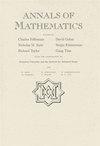全形凸集补集的奥卡性质 | 数学年刊
IF 5.7
1区 数学
Q1 MATHEMATICS
引用次数: 0
摘要
我们的主要定理指出,具有密度性质的斯坦因流形中紧凑全形凸集的补集是奥卡流形。这给出了奥卡理论中长期存在的一个著名问题的正面答案:在 $\mathbb{C}^{n}$ (n>1)$ 中的紧凑多项式凸集的补集是否是奥卡。此外,我们还得到了非椭圆奥卡流形的新例子,它们否定地回答了格罗莫夫的问题。我们还证明了主定理的相对版本。作为应用,我们证明了如果 $n>1$ 和 $(n,k)\neq (2,1),(2,2),(3,3)$ 是完全实的仿射子空间的补集 $\mathbb{C}^{n}\setminus \mathbb{R}^{k}$,那么它就是奥卡流形。本文章由计算机程序翻译,如有差异,请以英文原文为准。
Oka properties of complements of holomorphically convex sets | Annals of Mathematics
Our main theorem states that the complement of a compact holomorphically convex set in a Stein manifold with the density property is an Oka manifold. This gives a positive answer to the well-known long-standing problem in Oka theory whether the complement of a compact polynomially convex set in $\mathbb{C}^{n}$ $(n>1)$ is Oka. Furthermore, we obtain new examples of non-elliptic Oka manifolds which negatively answer Gromov’s question. The relative version of the main theorem is also proved. As an application, we show that the complement $\mathbb{C}^{n}\setminus \mathbb{R}^{k}$ of a totally real affine subspace is Oka if $n>1$ and $(n,k)\neq (2,1),(2,2),(3,3)$.
求助全文
通过发布文献求助,成功后即可免费获取论文全文。
去求助
来源期刊

Annals of Mathematics
数学-数学
CiteScore
9.10
自引率
2.00%
发文量
29
审稿时长
12 months
期刊介绍:
The Annals of Mathematics is published bimonthly by the Department of Mathematics at Princeton University with the cooperation of the Institute for Advanced Study. Founded in 1884 by Ormond Stone of the University of Virginia, the journal was transferred in 1899 to Harvard University, and in 1911 to Princeton University. Since 1933, the Annals has been edited jointly by Princeton University and the Institute for Advanced Study.
 求助内容:
求助内容: 应助结果提醒方式:
应助结果提醒方式:


